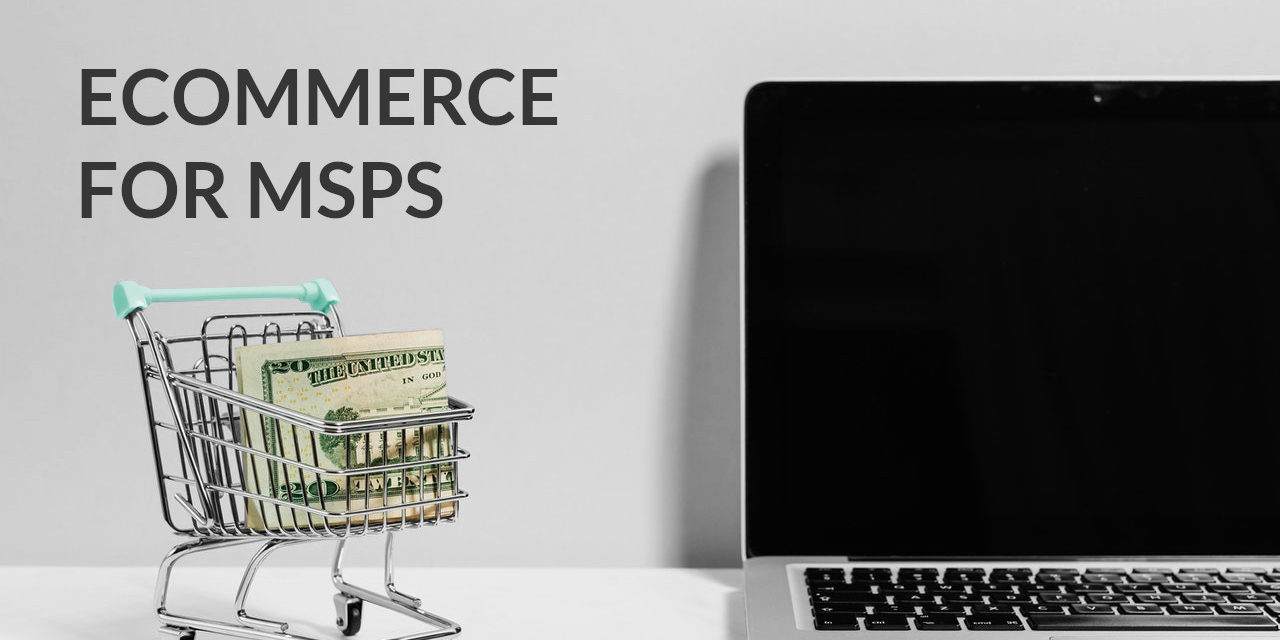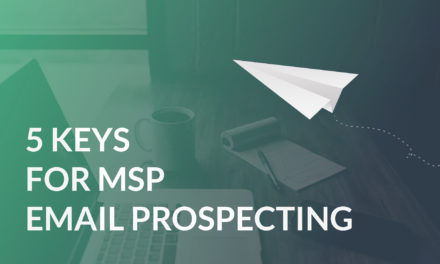Ecommerce Is A Hot Topic In The IT Channel
A few weeks ago, one of my favorite independent content creators in the IT Channel, Dave Sobel stirred the pot once again (as he is known to do) and this time, he is definitely on to something. The Founder of MSP Radio & Host of The Business Of Tech Podcast brings up the point that not enough Marketers, Vendors, and MSPs in the IT channel are talking about ecommerce as a serious consideration to sell products and services in a completely digital environment. You can see Dave’s epic rant here:
As expected, this video prompted a whirlwind of conversation around ecommerce for MSPs (a clear sign of Dave’s growing influence in the community). Many MSPs and vendors voiced objections as to why this wouldn’t work, while others used this as a doorway to rethink their own transactional relationship with customers and prospects and how it could be improved. No matter anyone’s opinion on this topic, this conversation is just getting started and there are signs everywhere that this will become a new reality for MSPs to adopt or contend with at some point in the not-so distant future.
Vendors & Distributors Are Enabling Change
Yesterday’s release of “Datto Commerce” is the next domino to fall in this direction. This new development from Datto aims to “simplify how MSPs quote, sell, and procure” products and services. While the primary function of this platform appears to be its quoting tool (similar to Connectwise Sell), it also boasts a customizable front-end ecommerce platform so that “you can enable your clients to purchase pre-approved products from you online 24/7.”
While data feeds from product and service suppliers such as Ingram Micro, D&H, and Tech Data are not exactly new, the turnkey ecommerce capabilities that this new platform offers will certainly change the game. Having this fully integrated with your PSA, as well as the much needed refresh to Autotask’s quoting procedure now becomes a very powerful enablement tool that is bound to have a positive impact for MSPs that utilize it. With Datto supporting over 17,000 MSP Partners, this is bound to drive ecommerce adoption in the MSP industry in a matter of months, not years.
The Ultimate Guide To Cash Flow For Managed Services
Sponsored by Alternative Payments & Zest
What MSPs Can Do With Ecommerce Capabilities
To add to this growing narrative, I want to help MSPs better understand what ecommerce capabilities (whether custom-developed or through a platform) could enable them to do from a marketing perspective, that their current process may not allow. You may feel as though this type of platform is not a fit for your business, and you may be right, but that does not change what will be possible for those who feel differently. These tactics will end up being just a few of the distinct advantages that MSPs who adopt ecommerce will have, that could lead to dramatic change to their business (and the industry).
Better Monetizing Customer Touchpoints
MSPs have a ton of touchpoints with their customers (like the Help Desk), that often go under-utilized. These are highly engaging interactions that would be the perfect opportunity to upsell products and services based on the context of the issue at hand. In my time as an MSP, getting technicians to sell from the Help Desk was not an easy task, primarily because sales was not within their comfort zone.
Ecommerce changes these interactions entirely. Help Desk technicians can simply pass off a link to a product or service without the burden of quoting, pitching and negotiating. Not only that, but your service desk is not the only touchpoint that you can now utilize. Email signatures, newsletters, invoices, payment portals, etc. can now be directly monetized in a way that is not otherwise possible without human interaction.
Full-Funnel Automation From PSA Triggers
By giving a client or prospect the ability to move through 100% of your funnel on their own, your focus can now be on automating ways to enable this process. Workflow automations in your Professional Service Automation tool are a great place to starts as you can now use real-time events as “triggers” to start the selling process for you.
Think of these workflow rules almost as drip campaigns that are kicked off based on certain statuses or classifications. For example, if a user submits a ticket for a phishing or spam-related incident, you can trigger a workflow that emails the Decision Makers a series of messages that recommend your Security Awareness Training service which can be purchased directly through ecommerce. In this case, you can take a behavior that already occurs (like the classification of a ticket) and built it into a sales process that requires no additional human input.
Hands-Off Product Refreshes Based On Lifecycle
Machine learning and AI are driving a ton of innovation around product lifecycles and warranties. MSPs are now able to use actual data to predict when hardware may reach the point of failure and stay one step ahead with timely refreshes. Up until now, this is primarily done through a platform (like Lifecycle Insights) which helps you prepare reporting and quotes for Quarterly Business Reviews (QBRs) with your clients to pitch them on your recommendations.
While this is a great process, it can certainly be improved with the introduction of an ecommerce environment. You can now use your lifecycle data to notify customers at the exact moment when a refresh is recommended and let them explore and buy pre-approved replacements on their own (in between Quarterly meetings). While not every customer will go for this, it allows for some progress to be made in between meetings and offers your client the illusion of “choice” as they browse products on their own time.
The Ultimate Guide To Cash Flow For Managed Services
Sponsored by Alternative Payments & Zest
Upsell & Cross-sell Based On Customer Segments
Not every one of your products or services is a fit for every customer, however not every customer is all that unique either. Segmenting your customer base allows you to group potential customers together based on common traits and market to them with more targeted messaging. In a recent mailchimp study, segmented email campaigns had a 14% higher open rate and 100% higher click rate than non-segmented campaigns.
While this tactic is entirely possible to implement without the presence of a ecommerce platform, it becomes that much more powerful with one. Not only can you build segments based on actual product level transaction data, but you can also use this to cross-sell and upsell additional products and services during or after the point of sale. For example, “customer who bought [this], also bought [that].”
Abandoned Cart & Product / Service Retargeting
Once you have an ecommerce platform in use and you are getting traffic to it consistently, you can begin to retarget visitors with ads based on what they have viewed or added to their cart. On average, 26% of visitors will return via these retargeting ads, which can increase ROI by a whopping 1300%.
This is data-driven marketing that you simply cannot achieve if you are manually quoting every deal in your funnel. Could you launch a general retargeting campaign based on your website activity? Yes. However an ecommerce environment give you insights into buyer intent that are not otherwise available when you optimize for basic lead generation.
Promotional Discounts, Deals & Coupons
One of the reasons marketing Managed Services (or most B2B services) can seem a little mundane is that there is rarely a promotional calendar throughout the year. With the exception of a few changes to bundles or services that may happen ad-hoc, it can be difficult to come up with attention-grabbing promotions that prompt customers and prospects to engage. An ecommerce platform can change this.
With the addition of ecommerce, MSPs can now create targeted promotions to refresh their pipeline on-demand and keep interest from flat-lining. They will also be able to avoid one-off negotiations on price. Consumers don’t often reach out to their favorite online retailer to negotiate a deal, but they will try to discover a discount code before purchasing. This allows standardized and controlled price reductions while building a sense of urgency into the buying experience.
Automated Affiliate Payments For Referrals
For those MSPs that prefer to grow only off referrals, ecommerce can help you do that too. Referral traffic is huge in the ecommerce world where it is known primarily as “affiliate marketing.” This would allow you to create unique links or codes for your top referrers and track the amount of revenue that they send your way. There are integrations that will allow you to automatically pay out these affiliate commissions on the interval of your choice, completely automating the process for you.
This becomes even more powerful if you are using your ecommerce platform to sell recurring services. By offering your affiliates a slice of recurring revenue for the life of the customer, you can monetize your social and professional networks like never before. It will also increase the amount of repeat referrals you receive, as these referrers get instant gratification from their efforts. This type of program would be difficult to be build without an ecommerce point of sale to track referral sources.

SPONSORED BY ZEST

















